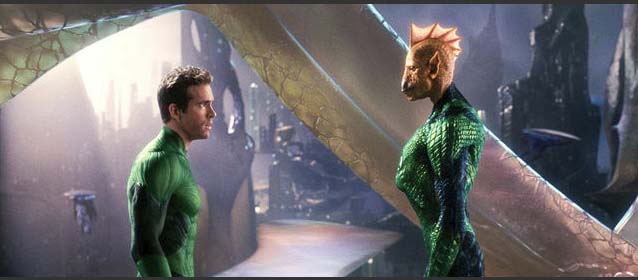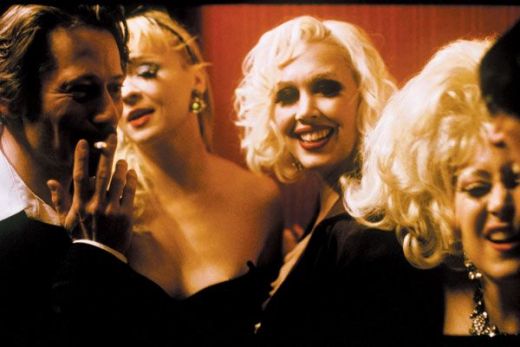Green Lantern isn’t as awful as The Green Hornet, but if this year’s cinema has taught us anything, it’s this: don’t trust a movie with “green” in the title. There are perhaps seven good minutes of action scattered within a soporific salmagundi of stilted scenes and here-for-the-paycheck performances. Our hero pulls off a few fun feats, such as responding to an energy bolt by creating a catapult in seconds, bouncing it back at his enemy. Green Lantern, famous among shut-ins who spend most of their time shrink-wrapping comics in basements for a fairly impressive party trick that transforms energy into solid matter, is tailor-made for CGI’s fluidity, especially because what Green Lantern creates (chainsaws, two jets attempting to steer him from the sun’s gravitational pull, and, most impressively, wheels attached to a helicopter and a corresponding racetrack) reveals his personality in modest ways.
It’s too bad that this effects-based commitment to character can’t be found anywhere in the lumbering script. One must sit through a plodding 90 minutes, including a murky beginning needlessly complicating a pedestrian origin story, to get to the good bits. And speaking of good bits, Ryan Reynold’s Hal Jordan has a chiseled body born to be ogled by a camera. Even as a straight man, I understood immediately why Scarlett Johansson felt compelled to ride his magic wand. Alas, this mighty chunk of sirloin doesn’t have much of a soul. Reynolds is a top gun firing blanks: a low-rent Maverick who never stops to wonder why Merlin is 25 years older, now answering to the name of Senator Robert Hammond, and playing father to an actor (Peter Sarsgaard) only twelve years younger. Unlike Tim Robbins, Sarsgaard’s Hector Hammond actually has a bit of fun being evil: he sips the rim of a margarita glass with arch relish, looks at strangers slightly askew, and has an adorably ridiculous moustache. For large chunks, Sarsgaard proves more capable of containing this movie than Reynolds Wrap. Alas, this wry fun is curtailed when the filmmakers slather too much makeup on Sarsgaard and ask the poor man to put a little spittle into his cornball dialogue.
Martin Campbell’s Green Lantern (written by Greg Berlanti, Michael Green, Marc Guggenheim, Michael Goldenberg, and who knows how many other script doctors) appears to have pilfered Emerald Dawn (a miniseries revisiting Hal Jordan’s origin story authored by Jim Owsley, Keith Giffen, and Gerard Jones) for its narrative. But the filmmakers have failed to plunder the conflict that counts. Emerald Dawn featured Hal as an alcoholic whose selfish behavior caused his friend Ryan to die in a hospital. Campbell’s Hal, by contrast, merely wakes up late and can’t get over his father’s fiery death years ago testing an aircraft. As internal conflicts for a thirtysomething man go, this is exceptionally feeble material, especially given the insistence on an internal will vs. internal fear conflict that we’ve seen perhaps dozens of times just in the past three years.
This is a film so stupid that it flashes a SIX MONTHS LATER title card in a different galactic sector, not comprehending that time measurement is often determined by length of solar orbit. This is a film so naive that it actually expects us to believe that Hal Jordan can change the minds of the Guardians of the Universe, who are many thousands of years old, with a facile defense of human fallacy (“We’re young. We have a lot to learn.”). This is a film so laughably derivative that the filmmakers have somehow misunderstood Green Lantern’s ring to be easily interchangeable with Peter Jackson’s Lord of the Rings trilogy. Sinestro looks suspiciously like Hugo Weaving’s Elrond. There is even talk of forging rings (with an arrogant ending that opens up a sequel). We even see the Green Lantern insignia contained within a giant edifice, yet another Mordor ripoff. Did I mention a circular device seen in the background that looks very much like the Stargate portal but that serves no function at all? One almost believes that the set designer was ordered by marketing forces to include random visual references to other geek-friendly TV shows and movies. A training scene with Kilowog has the feel and bad dialogue of a video game orientation, leaving one to search in the dark for a nonexistent controller.
But most criminally, the film cheats us of spectacular battles, which are few and far between, and a clearly identifiable hero we can root for. We see several Green Lanterns early on, but they never get to use their cool superpowers. They are merely eaten up by a boring marble-mouthed villain named Parallax. It takes a long while for Hal Jordan’s Green Lantern to show up. Indeed, thirty minutes into the film, I heard one very confused and very disappointed six-year-old ask his dad, “Is that Green Lantern?” as another meaningless character soared across the universe.
When multiplexes are saturated with so many superhero movies, why spend $300 million on another flick that means nothing?








